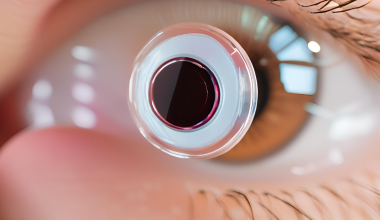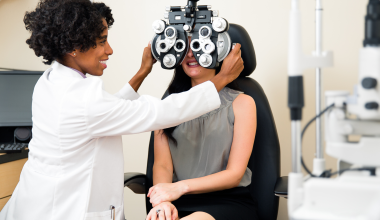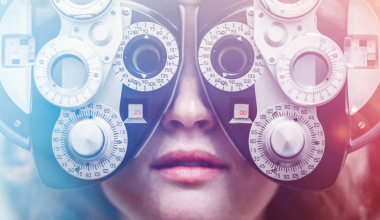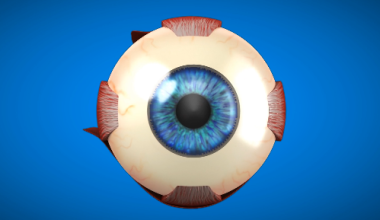Over the past 10 years or so, the vision of my 82-year-old mother has gotten progressively worse, so much so that she now prefers to listen to books rather than read. She can watch her beloved tennis matches, but the 5 set Grand Slam matches are hard on her eyes.
The reason for this is that she has age-related macular degeneration (AMD), one of the leading causes of vision loss for people over the age of 55. Today, AMD affects approximately 2.5 million Canadians.

What is Age-Related Macular Degeneration?
AMD is a degenerative disease that happens when part of the retina called the macula is damaged. It’s the part of the eye that delivers sharp, central vision needed to see objects straight ahead.
Over time, the loss of central vision can interfere with everyday activities, such as the ability to drive, read and see faces clearly. According to the Canadian Ophthalmological Society, AMD accounts for 90 per cent of new cases of legal blindness in Canada.
“While AMD affects older people, we want to emphasize the importance of being proactive about vision health in your earlier years to minimize the risk of getting this vision-stealing eye disease in the future. There is no cure however there are new medications for wet AMD becoming available that may provide greater duration of action, along with drugs to slow the progression of dry AMD, and innovations such as AI to help detect the eyes which have the greatest risk for progression.”
Dr. Phil Hooper, president of the Canadian Ophthalmological Society
Detecting and Treating AMD
Dry AMD is always the first stage of AMD, followed by wet AMD, which is the disease’s advanced, rapidly progressive form and is most likely to cause severe vision loss.

AMD usually starts in middle age, and there are generally no symptoms in the early stages. There are currently no treatments available in Canada for dry AMD, however new medications are on the horizon.
Artificial intelligence (AI) is being developed to detect AMD disease and those who have the highest risk of progression. This may help increase the ability of people to be screened without overwhelming the healthcare system.
Additionally, new drugs for wet AMD, such as Faricimab (Vabysmo), which has recently become available in Canada, promise greater durability of effect, and the potential for fewer injections needed to stabilize vision.
New medications to treat dry AMD such as SYFOVRE (pegcetacoplan) and Izervay (avacincaptad pegol or Zimura) can slow the progression of the disease over time and preserve visual function. While approved for use by The FDA in the US, these drugs are not yet available in Canada however it is hoped they will be in the next few years.
For now, there’s no way to reverse damage from dry macular degeneration. But if your condition is diagnosed early, you can take lifestyle steps to help slow its progression.
If you have dry AMD it is important to monitor your vision with an Amsler grid. The grid will help you detect the progression of dry AMD to the wet form of the disease at an early, treatable stage.
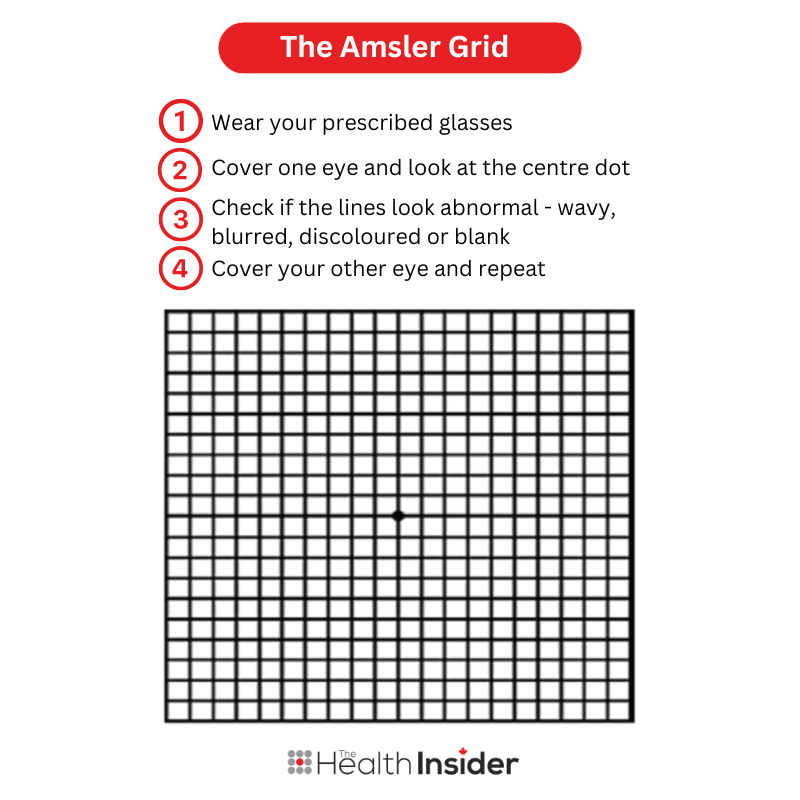
Lifestyle Choices – 6 Tips to Reduce Your Risk of AMD
While 80% of AMD cases are linked to heredity, and the biggest risk factor is age, there are other risk factors that may be within your control to change. These include:
1.Stopping smoking – Current smokers are exposed to a two to three times higher risk of AMD than non-smokers and the risk increases with intensity of smoking.
2. Increased physical activity – get up and move! Any heart pumping exercise can reduce your risk.
3. Managing your weight – obesity is a risk factor, along with diabetes.
4. Controlling blood pressure – get blood pressure under control, whether it be through medication, lifestyle choices or both.
5. Controlling cholesterol
- Reduce red meat and full-fat dairy products
- Eliminate trans fats
- Eat foods rich in omega-3 fatty acids
- Increase soluble fiber
6. Vitamins and minerals – taking the following every day may help lower risk of getting late-stage or wet AMD. Talk with your doctor about dosage and risks before taking these supplements.
- Vitamin C (ascorbic acid)
- Vitamin E
- Vitamin D
- Lutein
- Zeaxanthin
- Zinc (as zinc oxide)
- Copper (as cupric oxide)
If you have any of the risk factors, it’s a good idea to get screened once you hit your 50’s to hopefully avoid disability down the road.
Check here to review the cost of eye exams, and whether you’ll have to pay out of pocket in your province or territory. If you’re over 65 and diagnosed with AMD, exams every 12 months may be covered.
While my mother is in fantastic shape, eats well, and she’s getting treated for her AMD, I must face the genetic facts. My grandmother also had AMD, and with 80% of AMD cases driven by genetic predisposition, I think it might be time to get my eyes checked. How about you?
The information provided on TheHealthInsider.ca is for educational purposes only and does not substitute for professional medical advice. TheHealthInsider.ca advises consulting a medical professional or healthcare provider when seeking medical advice, diagnoses, or treatment.




